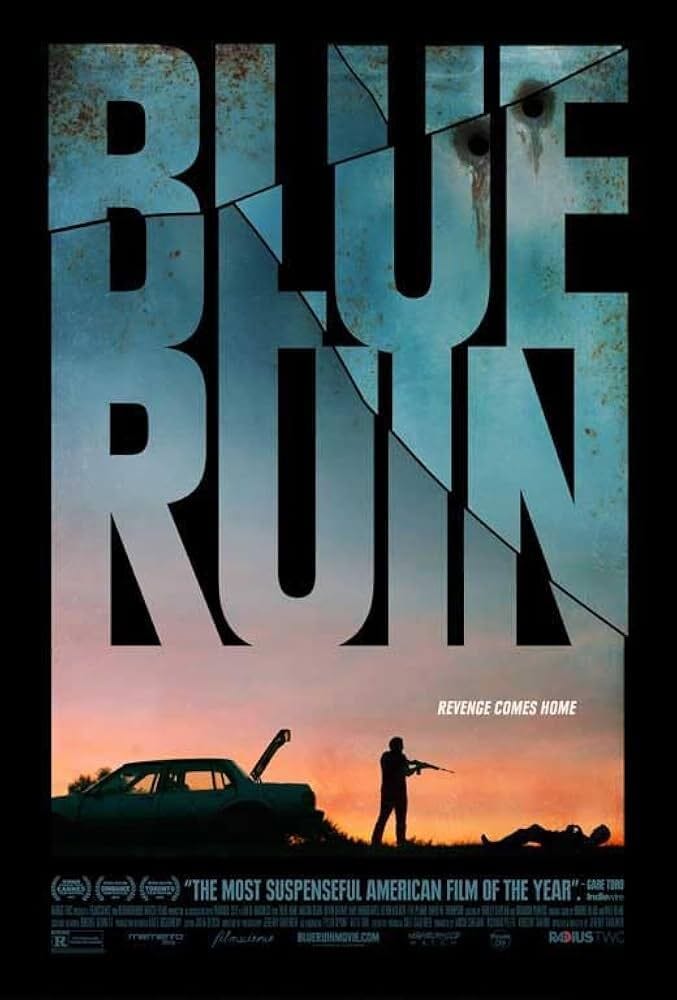TONIGHT’S FILM.
JEREMY SAULNIER’S “BLUE RUIN”.
It’s a thriller. You can watch it on Prime Video.
WELCOME BACK TO TUESDAY NIGHT.

New to tnmn? Here’s how you do it.
▶ If you prefer recommendations without commentary. Don’t scroll. You have the power to choose.
▶ If you don’t like the sound of this week’s movie. Scroll to our weekly community-sourced recommendations, just below this section. Or, log in and visit the tnmn archives.
▶ If you love ❤️ tnmn. Share the link to your friends: http://www.tuesdaynightmovienight.com/subscribe. If they don’t sign up, take it personally.1
JEREMY SAULNIER’S “BLUE RUIN”
WHAT IT IS.
A spoiler-free description of the movie.
A drifter receives bad news and decides to return home.
IF YOU LIKE.
If you like these things, then you’ll like the film.
▶ The Coen brothers. Slow burning, dark humor. Sudden bloody outbursts.
▶ Inexperienced assassins. There’s Keanu Reeves in “John Wick”, Matt Damon in “The Bourne Identity”. And then, there’s Macon Blair in “Blue Ruin” – a pug with weapons, practically.
▶ Child actors, older now. Jan from The Brady Bunch (Eve Plumb) and Buzz from Home Alone (Devin Ratray) are both in it. They both have where-have-I-seen-them-before faces.
MY TAKE.
What I liked about it.
For some filmmakers, a camera is simply a tool. Used to document; to record a picture. In Jeremy Saulnier’s “Blue Ruin”, you can feel his reverence for the camera. In his hands, the camera is a paintbrush. A way to add color, texture, and tone to a film. I said something is a paintbrush that isn’t a paintbrush. Call me trite.
"Blue Ruin" is an excellently drab revenge tale. Crafted precisely, by someone who grew up watching Clint Eastwood, the Coen brothers, and the like.
Saulnier’s focus on cinematography elevates what could have been an average film, otherwise. His camera work is visceral, purposeful. There are distinct breakpoints in the way the camera moves. Often bookending the emotional swings of his protagonist.
You can feel the camera shifting into gear throughout the film. Slowly disappearing into a cloud of fog along with our protagonist as we descend into his ill-advised mission to find vengeance. Nervously inching forward, step-by-step, when he feels unassured, inept, and unsafe. Gracefully floating alongside him in moments of strength or reflection.
I’m not sure I’ve admired this sort of device enough in other works. But perhaps I’ve not seen it done this well before.
Notice: since the late 1920’s, films have included sound as well as picture.2 So, paired with intelligent, purposeful camera movements in “Blue Ruin” is thoughtful sound design.
The film plays with contrast between loud and quiet, big and small. The click of an automated light switch is magnified in the silence of an abandoned house. A long pause after a weapon fires, punctuated long after when a projectile reaches its target. It feels, perhaps more than most, quite practical.
Most of all, “Blue Ruin” is a beautifully-acted film. Long reserved for actors with big muscles, flowing hair, and smiles beautiful enough to undress; Macon Blair brings a refreshingly plain, dud-like energy to the revenge-seeker archetype.
I’ll put it this way. Most actors view their faces as a tool. Used to express emotion. Macon Blair’s face is like a paintbrush.
Just kidding. About doing the paintbrush thing two times in one recommendation. I don’t think I’m going to do the paintbrush thing again.
Enjoy the film.
OH, NEAT.
A fact or two about the production that makes you say “oh, neat”.
▶ Jeremy Saulnier and Macon Blair, childhood friends who always dreamt of filmmaking together, returned to their Virginia hometown to shoot the majority of “Blue Ruin”. They even filmed in some of their family members’ houses. “When we started to go back through these areas,” Saulnier says, “I just felt this deep emotion…I needed to archive these spaces, just from a personal standpoint.”3
▶ To fund the film, Saulnier emptied his brokerage account. His wife liquidated her retirement account. Both of their mothers pitched in. Saulnier funded the rest of the total budget (under $300,000 altogether) with a Kickstarter campaign and an American Express Platinum. Making movies is expensive.3
THE QUOTE.
One great line of dialogue from the film.
I’d forgive you, if you were crazy. But you’re not. You’re weak.
See you next week!
Blake

1 Don’t take it personally. I’m kidding. This can really put unnecessary stress on a friendship.
2 https://jolsonville.net/2013/09/10/the-first-talkie/#more-1016
3 https://www.rollingstone.com/tv-movies/tv-movie-news/revenge-success-and-blue-ruin-243250/
